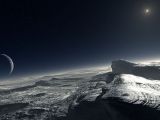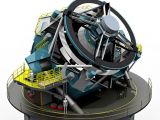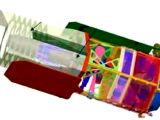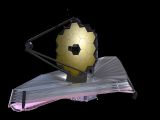Experts at the National Research Council (NRC) yesterday released their report on the future of space exploration and astronomy. The document, which is published once every 10 years, holds some interesting proposals for how humankind should carry on with its studies of the Universe.
Experts in the international astronomical community have been waiting eagerly for the new document, which indeed proposes a series of bold plans and instruments for space exploration.
The report is called “New Worlds, New Horizons in Astronomy and Astrophysics,” and it represents one of the main references that are usually cited by governments when deciding on new space plans.
The paper looks at the largest projects being proposed in the international scientific community, and analyzes the risks, readiness and costs they entail.
The NRC is a non-profit organization, whose goal is to produce valid and well-researched proposals for national authorities, space agencies, and other companies and organizations working in the field.
Highlights
Above all, the report indicates two of the projects that the NRC considered to be top priorities.
The first is the Wide-Field Infrared Survey Telescope (WFIRST), an instrument which is currently estimated to cost around $1.6 billion dollars to building
The second one is the LSST (Large Synoptic Survey Telescope), which would take about $465 million to construct, Wired reports.
“The community, both scientific and the American public, has come together around this notion of surveying the Universe in a complete way,” says the director of the LSST, Tony Tyson.
“I don't think there were losers. I think the entire community really won, and won big time,” says Columbia University astrophysicist Michael Shara, quoted by Space.
Exoplanets
One of the reoccurring themes in the NRC report was the study of exoplanets. Regardless of the size and scale of the project being investigated, the theme kept resurfacing.
Over the past few years, advancements made in observations technologies have allowed astronomers to peer deeper and deeper into the Universe, and to make out faint objects circling distant stars.
Numerous exoplanets and exomoons have been discovered in this manner, now that scientists are capable of blocking out light coming in from the parent stars around which the celestial bodies orbit.
“The study of exoplanets is of such enormous intellectual importance and it helps us understand our place in the universe,” explains the executive director of the Planetary Society, Louis Friedman.
But he says that studies conducting in such a difficult field of research never easy to justify, especially in terms of prospective costs and returns.
“What’s the effect and what’s the cost? You never know the trades that will go on once it gets into the bureaucracy,” Friedman says.
The expert is on the other hand convinced that smaller projects are key towards furthering our knowledge in this area.
He gives the example of the Gemini telescopes, which are a pair of twin telescopes located in Hawaii and Chile.
The observatories work based on the principle of optical interferometry, which means that they are able to combine the light they collect from space into pictures that have an extreme level of detail.
In effect, the images appear to have been snapped by a telescope with a mirror that has a diameter equal to the distance between the two telescopes.
Given the thousands of miles that separate the two, the photos they produce are extremely detailed, which enables them to conduct relevant exoplanetary research.
“Extra support for Gemini might just lead to some discovery that allows you to create a space experiment that makes a definitive discovery of a planet with habitable conditions,” Friedman believes.
But the NCR report is adamant that the LSST and the WFIRST are the most important projects currently in the works.
LSST
The Large Synoptic Survey Telescope is an 8.4-meter ground-based observatory, scheduled to be constructed in Chile. Its main light detector would be a 3-gigapixel camera.
The instrument would be capable of conducting full sky surveys of the area above the Southern Hemisphere once every 72 hours, its designers say.
One of its main objectives would be to study the distributions of visible and dark matter throughout the Universe, and also to determine the locations of as many supernovae as possible.
This would make it an invaluable asset to astrophysicists, who are having a hard time detecting dark matter, the stuff believed to make up for about 90 percent of the mass of the entire Universe.
Ground- and space-based detectors have until now been equally unsuccessful in discovering the stuff, but the NRC experts are convinced that a telescope the size of the LSST could be successful were other observations methods have failed.
Another function the proposed instrument could fulfill is as “guardian” for our planet. It could be used to watch out for dangerous near-Earth objects (NEO), providing space experts with ample warning times in the event of an unforeseen space collision.
“I think it's wonderful. Clearing the ground [for the telescope] is nothing compared to coming in first for the recommendations,” says Morgan May of the NRC's opinion on the LSST.
May is an astrophysicist at the US Department of Energy's (DOE) Brookhaven National Laboratory (BNL), in Upton, New York, where some of the most important sensors for the LSST are being constructed.
WFIRST
The second project, the Wide-Field Infrared Survey Telescope, proposes the construction of a 1.5-meter space observatory, that would be injected in the L2 Lagrangian point.
There are five such orbital points close to Earth. Spacecrafts located in each of them always remain in the same position relative to the Earth-Moon-Sun system.
WFIRST would be located about 1.5 million kilometers away from the planet, way beyond the orbit of the Moon. It's main job would be to conduct advanced studies into dark energy.
The stuff is believed to be the main driving force behind the ever-accelerating expansion of the Universe, although no clear evidences of its existence have thus far been produced.
A space mission is “what the problem requires,” says the deputy director of the LSST, Steve Kahn.
He is talking about a long-standing dispute in the astronomical community, as to whether a space mission – much like WFIRST – is really required in order to study dark energy.
“The principle benefit of space is to look into the infrared, which is blocked by the atmosphere. We can combine those results with the LSST visible light observations to reduce the systematic errors which are really limiting our measurements,” he adds.
Most researchers view the LSST and WFIRST as complementary approaches to the same goal – making sense of two of the most abstract and difficult-to-prove concepts in space sciences today.
Challenges ahead
The NRC document also includes some plans that NASA, for example, is having difficulties fulfilling.
“There are a few differences between what we are doing and what is in the report,” an agency official said under anonymity, as NASA is still looking into the data contained in the report.
In an official statement, the agency said: “From new worlds to new physics, the coming decade of discovery leverages not only our current space observatories – such as the Hubble, Spitzer, Chandra and Fermi space telescopes – but also our planned facilities – especially those from previous decadal surveys, the James Webb Space Telescope and the Stratospheric Observatory for Infrared Astronomy (SOFIA).
NASA is now struggling to make sense of its future. President Barack Obama and Administrator Charles Bolden are proposing one thing, while Congress and congressmen are passing legislation that states another thing entirely.
For example, Obama had proposed at the beginning of this year that the federal government assist private companies in their quest to ferry astronauts in orbit, but a new bill passed by the Senate withdrew funding.
Instead, the money was redirected to the design and development of a new heavy-lift rocket, which would be capable of ferrying manned space capsules to the International Space Station (ISS).
The American space agency also needs to be attentive to its other projects, such as the James Webb Space Telescope (JWST).
This is planned to be Hubble's successor but, oddly enough, the NRC document did not mention it in this particular role.
This oversight or omission left many astronomers wondering as to the rationale behind it.
We've been acquiring data via a “phenomenal UV telescope, i.e. Hubble, for the last 20 years, and we're getting it for another five [years],” says Shara.
He adds that many of his colleagues cannot understand how the NRC mentioned the LSST and WFIRST, but without making any kind of reference to the JWST.
In the end, the report recognizes that space exploration is not exactly at the top of the spending agenda for the US government, or for other countries.
“This is a challenging time for anywhere in the world. But if there is a will there will be money found. I think there is a will,” concludes Tony Tyson.
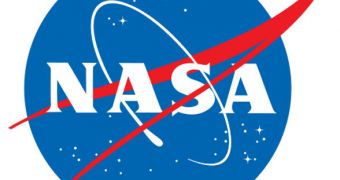
 14 DAY TRIAL //
14 DAY TRIAL // 
